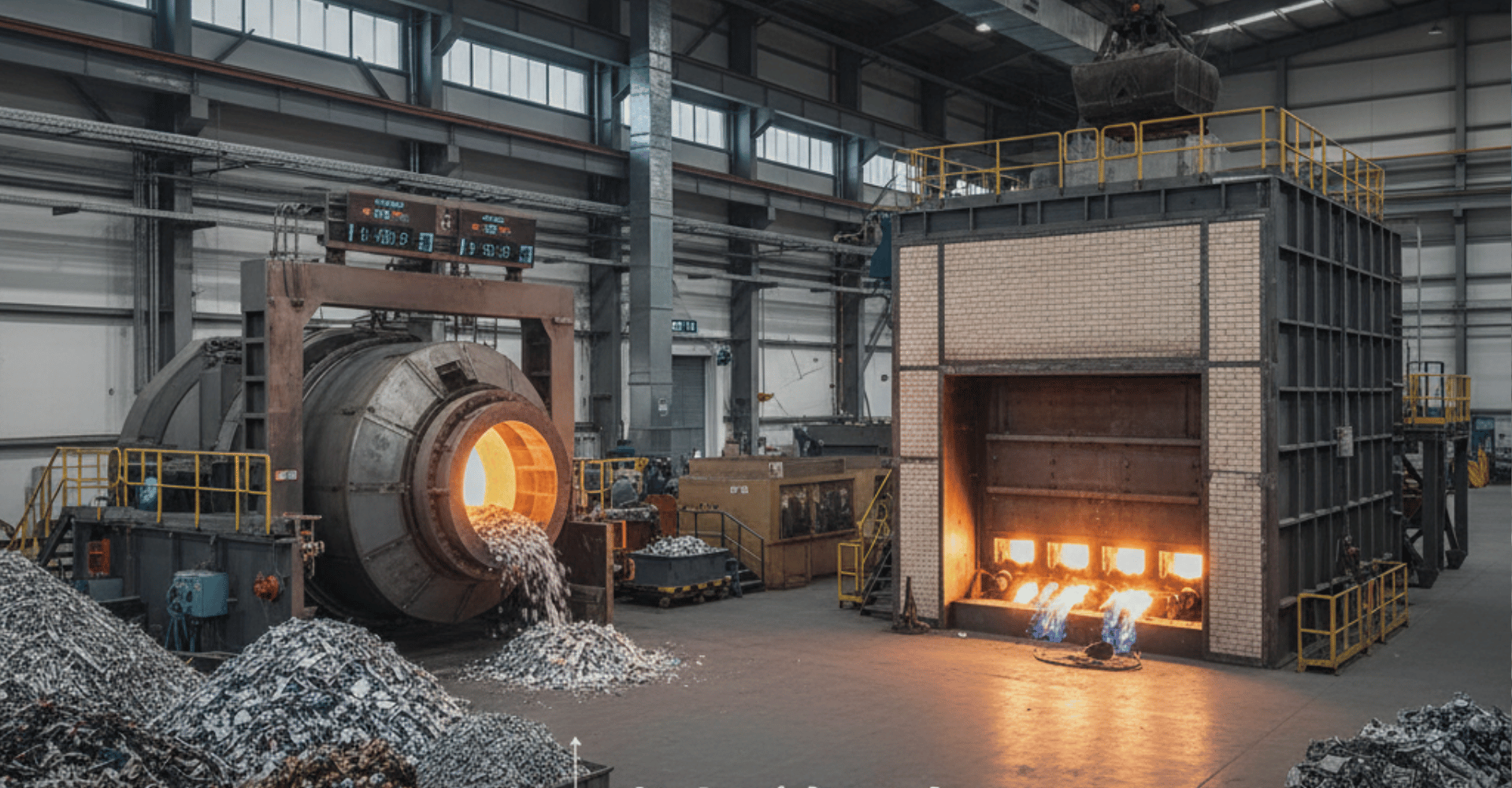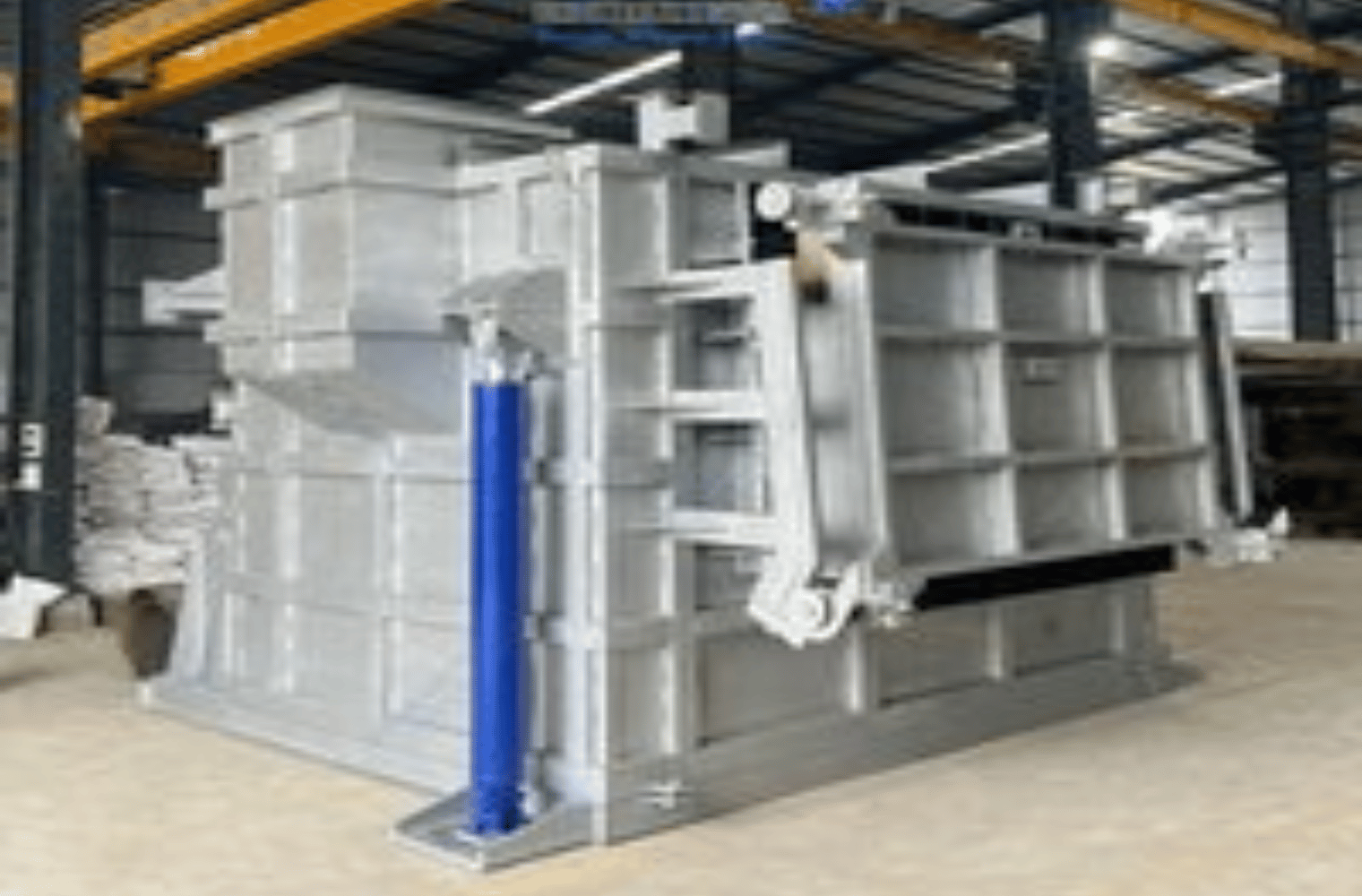Furnace Selection
Different types of furnaces for melting Al scrap are used, depending on the initial metal content in the scrap, type and content of impurities, geometry of the scrap, and frequency of change in the alloy composition, operating conditions, energy cost, and desired product quality.
Where energy cost is high as in Europe, the energy efficiency has been an operating priority for many years. For this reason, rotary furnaces are more common than reverberator furnaces in Europe. In contrast, in the United States 95% of Al scrap is melted in gas reverberator furnaces, which operate with a lower energy efficiency (20–30%) and require lower capital cost. They are easier to operate and maintain than rotary furnaces. Two important criteria to be considered during furnace selection are the metal content in the scrap (metal yield) and the production volume. Figure reports the main available solutions considering these features.


Reverberator Furnace
Reverberatory furnaces are brick-lined and constructed with a curved roof. Furnace design is simple, rectangular or round, depending on the specific application. The rectangular design with the front door across the full furnace width allows for maximum access during charging and skimming. The molten metal is held inside the furnace at the required temperature before tapping.
Typical reverberatory furnaces present energy efficiency, i.e., the ratio between the amount of heat absorbed by the raw material and the amount of heat from the total consumed fuel, in the range of 15–39%. The main advantages provided by reverberatory furnaces are the high volume processing rate, and the low operating and maintenance costs. The disadvantages refer to the high metal oxidation rate, low energy efficiency, and large space requirements.
Charging
Pre-treated scrap is generally charged into the melting furnace mixed with fluxes. Scrap may be charged as high density bales, loosely packed bales, or as dry shredded scrap from a conveyor. In order to minimize the aluminum oxidation, and consequently the melt loss, the scrap is mechanically submerged into the liquid bath as quickly as possible. The melting process is aimed to maximize the metal recovery, i.e., the ratio between the aluminum present in the scrap and the secondary aluminum obtained.
Refine Processes
Fluxing indicates the addition of chemical compounds in the scrap feed to improve the recovery of aluminum and the quality too. Fluxes are usually classified depending on their application. Four categories can be individuated: cover and drossing fluxes, cleaning fluxes, and furnace wall cleaning fluxes.
Most salt fluxes are made from sodium and potassium chlorides. They present a melting point of 801 and 771 ◦C respectively, but they form a lower temperature eutectic at 657 ◦C and a high fluidity mixture if the flux is based on an equimolar ratio of these chlorides.
Fluxing
Fluxing is temperature dependent. Temperature must be appropriately selected to provide for good contact and reactivity, and for achieving a good physical separation. Excessive temperature increases energy loss and causes fume and gas formation. It causes the fluxing treatment to make skimming more difficult and it reduces the accuracy and efficiency of the refining process.
Degassing
Depending on the specific situation, refining treatments can be also carried out, such as degassing .The first is the simplest method to remove dissolved hydrogen and sodium, and it can be achieved by purging gas with inert as well as reactive gases, the application of a vacuum, tableted flux degassing, or mechanical stirring. On the other side, demagging fluxes are used when the melt contains excessive amounts of magnesium. The flux helps to reduce the magnesium content by burning (oxidizing) it from the melt.
Dross
Dross is classified according to the metal content into white dross, generated from primary smelter, and black dross, from secondary refiners. White dross may contain from 15% to 70% recoverable metallic aluminum and it comprises a fine powder from skimming the molten aluminum. Black dross typically contains a mixture of Al oxides and slag, with recoverable Al content ranging between 12% and 18%, and a much higher salt content than the white dross, typically greater than 40%. The non-metallic residues generated from the dross smelting operations contain metal beads, crystallized salt, and solid non-metallic particles.
Aluminum metal, salt, and compounds containing alumina are recoverable as high quality products for the recycling process, or sold as non-toxic material. Today, the treatment of the salt slag is generally done in the US, Canada, and Europe, where export this slag to different countries for further segregation because landfill is prohibited by law. The treatment of the salt cake also has a considerable economic impact. Actually, the recovery of the residual metallic aluminum and the salt fraction (halite, NaCl, and sylvite, KCl) is permitted and this justifies, for large refining companies, the investment in an on-site salt cake recycling facility.
Conclusions
Secondary Al production is continuously increasing because it offers economic and environmental advantages. Different types of Al scrap exist according to the amount of alloying elements and impurities, even if the most essential input material for Al recycling remains metal recovered from fabrication aluminum scrap. Large amounts of Al scrap are currently recycled by downgrading and dilution, due to difficulties in refining. These two strategies induce a surplus of Al scrap that can’t be used in the recycling chain.
The selection of the melting furnace is a critical aspect and it depends on the quality and quantity of scrap. Each solution has the same objective: generate the highest melting capacity per unit volume while maximizing the thermal efficiency to reduce the energy cost and cycle time. Electric furnaces are typically used in small processing operations, i.e., where Al scrap is usually home-made rather than purchased material. The electric furnaces cannot compete in terms of melting capacity with the large-scale fossil-fuel furnaces, such as reverberatory and rotary furnaces, which remain the main technologies. Several improvements on these furnaces have been implemented. Important results have been achieved by exhaust gas recirculation, regenerative burners, and molten metal pumps.
Many technologies and innovations from scrap upgrading to the melting process appear to be robust and warrant further research and development in the Al recycling process.
Bag House Filter System
Bag houses utilize fabric filter bags or pleated filters arranged in rows and mounted vertically in a sheet metal housing. They are designed to receive dusty gas from fugitive or process sources, capture the particulates, and exhaust clean air.

